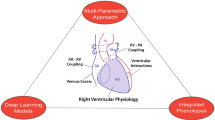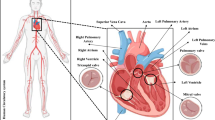Abstract
Despite its vital importance for establishing proper cardiovascular function, the process through which the vasculature develops and matures postnatally remains poorly understood. From a clinical perspective, an ability to mechanistically model the developmental time course in arteries and veins, as well as to predict how various pathologies and therapeutic interventions alter the affected vessels, promises to improve treatment strategies and long-term clinical outcomes, particularly in pediatric patients suffering from congenital heart defects. In the present study, we conducted a multiscale investigation into the postnatal development of the murine thoracic aorta, examining key allometric relations as well as relationships between in vivo mechanical stresses, collagen and elastin expression, and the gradual accumulation of load-bearing constituents within the aortic wall. Our findings suggest that the production of fibrillar collagens in the developing aorta associates strongly with the ratio of circumferential stresses between systole and diastole, hence emphasizing the importance of a pulsatile mechanobiological stimulus. Moreover, rates of collagen turnover and elastic fiber compaction can be inferred directly by synthesizing transcriptional data and quantitative histological measurements of evolving collagen and elastin content. Consistent with previous studies, we also observed that wall shear stresses acting on the aorta are similar at birth and in maturity, supporting the hypothesis that at least some stress targets are established early in development and maintained thereafter, thus providing a possible homeostatic basis to guide future experiments and inform future predictive modeling.







Similar content being viewed by others
References
Calzolari E, Garani G, Cocchi G et al (2003) Congenital heart defects: 15 years of experience of the Emilia-Romagna Registry (Italy). Eur J Epidemiol 18:773–780
Cannon WB (1932) The Wisdom of the Body. Norton & Co
Chang SW, Buehler MJ (2014) Molecular biomechanics of collagen molecules. Mater Today 17(2):70–76
Cheng JK, Wagenseil JE (2012) Extracellular matrix and the mechanics of large artery development. Biomech Model Mechanobiol 11:1169–1186
Davis EC (1993) Stability of elastin in the developing mouse aorta: a quantitative radioautographic study. Histochemistry 100(1):17–26
Davis EC (1995) Elastic lamina growth in the developing mouse aorta. J Histochem Cytochem 43(11):1115–1123
Dawson TH (2014) Allometric relations and scaling laws for the cardiovascular system of mammals. Systems 2(2):168–185
Dingal PDP, Discher DE (2014) Systems mechanobiology: tension-inhibited protein turnover is sufficient to physically control gene circuits. Biophys J 107(11):2734–2743
Eberth JF, Popovic N, Gresham VC et al (2010) Time course of carotid artery growth and remodeling in response to altered pulsatility. Am J Physiol Heart Circ Phys 299(6):H1875–H1883
Espinosa MG, Taber LA, Wagenseil JE (2018) Reduced embryonic blood flow impacts extracellular matrix deposition in the maturing aorta. Dev Dyn 247(7):914–923
Estrada AC, Irons L, Rego BV et al (2021) Roles of mTOR in thoracic aortopathy understood by complex intracellular signaling interactions. PLoS Comput Biol 17(12):e1009683
Ferruzzi J, Bersi M, Humphrey J (2013) Biomechanical phenotyping of central arteries in health and disease: advantages of and methods for murine models. Ann Biomed Eng 41(7):1311–1330
Ferruzzi J, Di Achille P, Tellides G et al (2018) Combining in vivo and in vitro biomechanical data reveals key roles of perivascular tethering in central artery function. PLoS ONE 13(9):e0201379
Gentles TL, Mayer JE Jr, Gauvreau K et al (1997) Fontan operation in five hundred consecutive patients: factors influencing early and late outcome. J Thorac Cardiovasc Surg 114(3):376–391
Gerrity R, Cliff W (1975) The aortic tunica media of the developing rat. I. quantitative stereologic and biochemical analysis. Lab Invest 32(5):585–600
Gibbons GH, Dzau VJ (1994) The emerging concept of vascular remodeling. N Engl J Med 330(20):1431–1438
Gleason R, Gray S, Wilson E et al (2004) A multiaxial computer-controlled organ culture and biomechanical device for mouse carotid arteries. J Biomech Eng 126(6):787–795
Goriely A (2017) The Mathematics and Mechanics of Biological Growth. Springer, Berlin
Greve JM, Les AS, Tang BT et al (2006) Allometric scaling of wall shear stress from mice to humans: quantification using cine phase-contrast MRI and computational fluid dynamics. Am J Physiol Heart Circ Physiol 291(4):H1700–H1708
Gupta V, Grande-Allen KJ (2006) Effects of static and cyclic loading in regulating extracellular matrix synthesis by cardiovascular cells. Cardiovasc Res 72(3):375–383
Hoffman JI, Kaplan S (2002) The incidence of congenital heart disease. J Am Coll Cardiol 39(12):1890–1900
Holt J, Rhode E, Holt W et al (1981) Geometric similarity of aorta, venae cavae, and certain of their branches in mammals. Am J Physiol Regul Integrat Comp Physiol 241(1):R100–R104
Hudson DM, Garibov M, Dixon DR et al (2017) Distinct post-translational features of type I collagen are conserved in mouse and human periodontal ligament. J Periodontal Res 52(6):1042–1049
Humphrey J (2021) Constrained mixture models of soft tissue growth and remodeling-twenty years after. J Elast 145(1–2):49–75
Humphrey JD (2001) Stress, strain, and mechanotransduction in cells. J Biomech Eng 123(6):638–641
Humphrey JD (2002) Cardiovascular solid mechanics: cells, tissues, and organs. Springer Science & Business Media
Humphrey JD (2008) Mechanisms of arterial remodeling in hypertension: coupled roles of wall shear and intramural stress. Hypertension 52(2):195–200
Humphrey JD, Rajagopal K (2002) A constrained mixture model for growth and remodeling of soft tissues. Math Models Methods Appl Sci 12(03):407–430
Huo Y, Kassab GS (2012) Intraspecific scaling laws of vascular trees. J R Soc Interface 9(66):190–200
Huxley JS, Teissier G (1936) Terminology of relative growth. Nature 137(3471):780–781
Kelleher CM, McLean SE, Mecham RP (2004) Vascular extracellular matrix and aortic development. Curr Top Dev Biol 62:153–188
Langille B, Brownlee R, Adamson S (1990) Perinatal aortic growth in lambs: relation to blood flow changes at birth. Am J Physiol Heart Circ Physiol 259(4):H1247–H1253
Langille BL (1996) Arterial remodeling: relation to hemodynamics. Can J Physiol Pharmacol 74(7):834–841
Le VP, Cheng JK, Kim J et al (2015) Mechanical factors direct mouse aortic remodelling during early maturation. J R Soc Interface 12(104):20141350
Leung D, Glagov S, Mathews M (1977) Elastin and collagen accumulation in rabbit ascending aorta and pulmonary trunk during postnatal growth. Correlation of cellular synthetic response with medial tension. Circ Res 41(3):316–323
Li W, Li Q, Jiao Y et al (2014) Tgfbr2 disruption in postnatal smooth muscle impairs aortic wall homeostasis. J Clin Investig 124(2):755–767
Lim HY, Lim SY, Tan CK et al (2018) Hyaluronan receptor LYVE-1-expressing macrophages maintain arterial tone through hyaluronan-mediated regulation of smooth muscle cell collagen. Immunity 49(2):326–341
Lucitti JL, Visconti R, Novak J et al (2006) Increased arterial load alters aortic structural and functional properties during embryogenesis. Am J Physiol Heart Circ Physiol 291(4):H1919–H1926
Mahle WT, Hu C, Trachtenberg F et al (2018) Heart failure after the Norwood procedure: an analysis of the single ventricle reconstruction trial. J Heart Lung Transplant 37(7):879–885
McCullagh K, Duance V, Bishop KA (1980) The distribution of collagen types I, III and V (AB) in normal and atherosclerotic human aorta. J Pathol 130(1):45–55
McLean SE, Mecham BH, Kelleher CM et al (2005) Extracellular matrix gene expression in the developing mouse aorta. Adv Dev Biol 15:81–128
Murtada SI, Kawamura Y, Li G et al (2021) Developmental origins of mechanical homeostasis in the aorta. Dev Dyn 250(5):629–639
Nabeshima Y, Grood E, Sakurai A et al (1996) Uniaxial tension inhibits tendon collagen degradation by collagenase in vitro. J Orthop Res 14(1):123–130
Nissen R, Cardinale GJ, Udenfriend S (1978) Increased turnover of arterial collagen in hypertensive rats. Proc Natl Acad Sci 75(1):451–453
Plackett B et al (2021) The surgical solution to congenital heart defects. Nature 599(7886):21–21
Rachev A, Stergiopulos N, Meister JJ (1996) Theoretical study of dynamics of arterial wall remodeling in response to changes in blood pressure. J Biomech 29(5):635–642
Rego BV, Weiss D, Bersi MR et al (2021) Uncertainty quantification in subject-specific estimation of local vessel mechanical properties. Int J Numer Methods Biomed Eng 37(12):e3535
Rosenthal JS (2011) Optimal proposal distributions and adaptive MCMC. Handbook of Markov Chain Monte Carlo 4(10.1201)
Schroeder F, Polzer S, Slažanskỳ M et al (2018) Predictive capabilities of various constitutive models for arterial tissue. J Mech Behav Biomed Mater 78:369–380
Spronck B, Ramachandra AB, Moriyama L et al (2022) Deletion of matrix metalloproteinase-12 compromises mechanical homeostasis and leads to an aged aortic phenotype in young mice. J Biomech 141:111179
Taber L (1998) A model for aortic growth based on fluid shear and fiber stresses. J Biomech Eng 120(3):348–354
Taber LA (2009) Towards a unified theory for morphomechanics. Philosophical transactions of the royal society a: mathematical, physical and engineering sciences 367(1902):3555–3583
Taber LA (2020) Continuum Modeling in Mechanobiology. Springer, Berlin
Thompson D (1917) On Growth and Form. Cambridge University Press, Cambridge
Valentin A, Humphrey J (2009) Evaluation of fundamental hypotheses underlying constrained mixture models of arterial growth and remodelling. Philosophical Trans R Soc A Math Phys Eng Sci 367(1902):3585–3606
Van Der Linde D, Konings EE, Slager MA et al (2011) Birth prevalence of congenital heart disease worldwide: a systematic review and meta-analysis. J Am Coll Cardiol 58(21):2241–2247
Wagenseil JE (2011) A constrained mixture model for developing mouse aorta. Biomech Model Mechanobiol 10:671–687
Weiss D, Latorre M, Rego B et al (2021) Biomechanical consequences of compromised elastic fiber integrity and matrix cross-linking on abdominal aortic aneurysmal enlargement. Acta Biomater 134:422–434
White L, Haines H, Adams T et al (1968) Cardiac output related to body weight in small mammals. Comp Biochem Physiol 27:559–565
Wiesmann F, Ruff J, Hiller KH et al (2000) Developmental changes of cardiac function and mass assessed with MRI in neonatal, juvenile, and adult mice. Am J Physiol Heart Circ Physiol 278(2):H652–H657
Wolinsky H, Glagov S (1967) A lamellar unit of aortic medial structure and function in mammals. Circ Res 20(1):99–111
Yeo GC, Keeley FW, Weiss AS (2011) Coacervation of tropoelastin. Adv Coll Interface Sci 167(1–2):94–103
Acknowledgements
This work was supported by Additional Ventures (AVCC) and the National Institutes of Health (R01 HL155105).
Author information
Authors and Affiliations
Corresponding author
Ethics declarations
Conflict of interest
The authors declare no conflicts of interest, financial or otherwise.
Additional information
Publisher's Note
Springer Nature remains neutral with regard to jurisdictional claims in published maps and institutional affiliations.
Supplementary Information
Below is the link to the electronic supplementary material.
Rights and permissions
Springer Nature or its licensor (e.g. a society or other partner) holds exclusive rights to this article under a publishing agreement with the author(s) or other rightsholder(s); author self-archiving of the accepted manuscript version of this article is solely governed by the terms of such publishing agreement and applicable law.
About this article
Cite this article
Rego, B.V., Murtada, SI., Li, G. et al. Multiscale insights into postnatal aortic development. Biomech Model Mechanobiol 23, 687–701 (2024). https://doi.org/10.1007/s10237-023-01800-8
Received:
Accepted:
Published:
Issue Date:
DOI: https://doi.org/10.1007/s10237-023-01800-8




